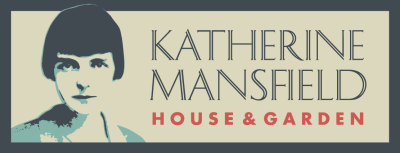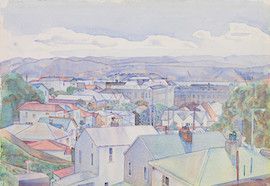
'Early Morning, Thorndon' by Rita Angus. Christchurch Art Gallery Te Puna o Waiwhetū, 2002/147.
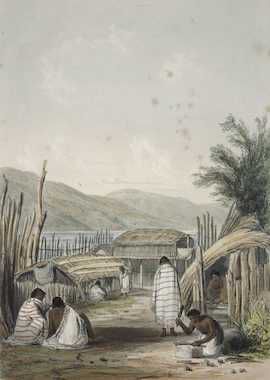
Courtyard in Pipitea Pā, 1842 by William Mein Smith. Alexander Turnbull Library, PUBL-0011-04-1.

Hobson Street, Thorndon, looking towards Mt Victoria, c.1859. Alexander Turnbull Library, PA1-f-019-18-3.
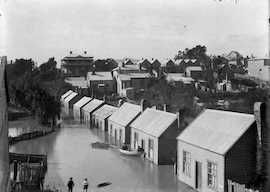
A flooded street in Thorndon, 1893. On the hill above the little cottages is Katherine Mansfield's large family home. Alexander Turnbull Library, MNZ-1348-1/2-G.
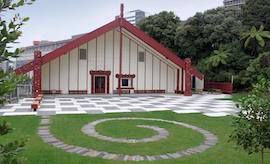
Pipitea Marae, 2016. Courtesy of the Pipitea Marae Facebook page.
Thorndon
Thorndon is one of Aotearoa New Zealand’s oldest suburbs. It has had an eventful past and has been variously populated by Māori chiefs, politicians and Prime Ministers, painters, writers, bishops and composers – all of whom have shaped our nation and identity in some way.
The story of Thorndon is far richer and greater than is able to be covered on this page, which is designed to provide a short overview and highlight a few points of interest relevant to Katherine Mansfield House & Garden.
For teachers considering exploring Thorndon’s history with their students, Thorndon provides an opportunity to study the history of colonisation in New Zealand through a local lens. It is also an interesting case study of the development of a city over time, and the impact of a changing society on the landscape of a place. Thorndon’s stories relate to the studies of New Zealand history, English, geography, New Zealand art history, and much more. There are a number of important heritage sites in Thorndon in close proximity and the staff of these sites can work together to create an engaging and rewarding trip for students learning about the history of Thorndon and Aotearoa New Zealand. Please contact us to find out more.
Brief history
According to some iwi narratives, the first Polynesian visitor to what is now known as Wellington was Kupe, in the 900s BCE. Later came Tara, the great-great-grandson of Kupe, who had been sent by his father Whatonga from further up the island to look for a place to settle. Wellington’s name in te reo – Te Whanganui a Tara, the great harbour of Tara – derives from him. His descendants were the Ngāi Tara people (later called Muaūpoko), who lived around Te Whanganui a Tara and on the Kāpiti Coast.
In the mid-1820s, armed conflict with Te Rauparaha and Ngāti Toa caused some Taranaki iwi (tribes), namely Te Āti Awa, Ngāti Tama and Ngāti Mutunga, to migrate down the island to Te Whanganui a Tara. The areas now known as Thorndon and Pipitea were particularly attractive due to their flat land and proximity to the harbour. A fortified pā called Pipitea was built at the edge of the harbour and kāinga (villages) were established nearby. A kāinga known as Pakuao was situated very close to what is now the site of Katherine Mansfield House & Garden. Water flowed down from Te Ahumairangi, the hill to the west, and the land was good for crops and rich in birdlife.
Scroll down to ‘Piptea Pa’ in this online tool to see where Pipitea Pā was located in today’s landscape. You might be surprised by the shoreline!
By the 1820s, Europeans were also beginning to arrive in what they initially called Port Nicholson. In 1825, the London-based New Zealand Company, set up to promote and organise a British colony in New Zealand, sent scouts out to find a suitable settlement site. They entered Wellington Harbour and decided it was suitable. It was intended that Wellington would be the first organised settlement and the new colony’s capital city.
In 1839 the New Zealand Company cheaply acquired large amounts of land from two chiefs of Te Āti Awa, Te Puni and Te Wharepouri, for the establishment of Wellington. In 1840 European colonists arrived and named this area Thorndon after the Essex home of the New Zealand Company director, Lord Petre. While Wellington had been intended as the original capital of New Zealand, Auckland was initially chosen. However, in 1865 Wellington became the capital city and Thorndon the home of New Zealand’s Parliament.
From its early days Thorndon was quite a mixed suburb that was home to large houses and prominent families, as well as workers and their families in tiny cottages. Katherine Mansfield’s story ‘The Garden Party’ is set in Thorndon and follows the preparations for a garden party at the home of the Sheridan family, which has a tennis court and a team of servants. However, just down the road are little cottages.
“...the little cottages were in a lane to themselves at the very bottom of a steep rise that led up to the house...They were the greatest possible eyesore, and they had no right to be in that neighbourhood at all. They were little mean dwellings painted a chocolate brown. In the garden patches there was nothing but cabbage stalks, sick hens and tomato cans...Washerwomen lived in the lane and sweeps and a cobbler, and a man whose house-front was studded all over with minute bird-cages. Children swarmed...It was disgusting and sordid.”
There is still a mix of big and small houses in Thorndon, many dating back to the 19th and early 20th century. However, where once there were greengrocers and small shops, there are now high-rise office blocks on Molesworth Street and the streets close to Parliament. Thorndon also has a number of high-rise apartment buildings dotted through it. After the Second World War, there was an acute housing shortage and high-rise development was promoted as a solution to clearing slums and limiting urban sprawl. The Council was slow to introduce formal planning measures to enable and promote such development, so it wasn’t until the 1960s that the apartments blocks now seen in Thorndon were actually built. By the 1970s there was opposition to such development and the Council made changes to reduce the maximum height for new buildings in suburbs such as Mt Victoria and Thorndon.
The recognition of mana whenua is an important recent change in Thorndon. Pipitea Marae opened on 31 May 1980 and is one of a number of urban marae that opened from the 1960s, as the number of Māori living in urban centres dramatically increased. The Marare is a place for people of all iwi and races to meet and mixes traditional kawa and protocol with commercial offerings such as conferences, meetings and a car parking building.
The new suburb of Pipitea was created in 2003. It includes the site of the original Pipitea Pā, Parliament and much of the reclaimed land along the railway lines and the port.
Te Āti Awa of Wellington shared in a treaty settlement signed on 19 August 2008 with Taranaki Whānui ki Te Upoko o Te Ika. The financial component of this settlement, valued at $25 million, included the option to buy and lease back Crown properties in Thorndon, including Archives New Zealand, the National Library of New Zealand, the High Court and Wellington Girls’ College.
Several sites of traditional, historical, cultural and spiritual association with Taranaki Whānui ki Te Upoko o Te Ika, including Matiu/Somes Island, Mokopuna Island and Mākaro/Ward Island in Wellington Harbour, were vested in those tribes.
There is growing interest in traditional place names throughout New Zealand, including correcting misspelt names such as Te Wharepōuri Street in Newtown in 2020. The video below from Wellington Museum explains the meaning behind the name Tinakori Road in Thorndon, and why the current spelling isn’t correct.
Like any place, Thorndon continues to evolve. It is a place of many stories with new chapters to come.
To begin to learn more about the history of Thorndon and Wellington, check out these websites:
Te Ara: The Encyclopedia of New Zealand’s entry on Wellington - https://teara.govt.nz/en/wellington-region
Wellington City Council’s Heritage and Local History page - https://www.wcl.govt.nz/heritage/
With thanks to Tamara Patten of Old St Paul's for her input into this brief history.
